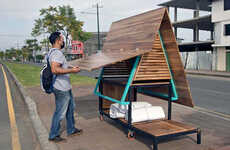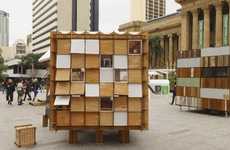
This Temporary Housing Unit Becomes a Home to Victims of Damaged Property
Amelia Roblin — January 10, 2013 — Eco
References: yankodesign
Plenty of designers are caught up in the competition to design the most practical emergency shelter possible. The Temporary Housing Unit by Michel Antoun Zateef is one of such proposals that would serve to put a roof over catastrophe victims' heads.
Whether it's a flood, a hurricane, an earthquake or another type of natural disaster that affects a community, this project aims to bring some comfort and many of life's necessities to people who are left homeless. The boxy dwellings are intended for short-term use only, and ideal for later transportation to another site of destruction.
They can be moved easily on a truck or a train thanks to a compact form and lightweight compressed strand board material. The Temporary Housing Unit has retractable solar panels for self-sufficient electricity, plus sleeping, cooking and bathroom facilities packed into its tiny area.
Whether it's a flood, a hurricane, an earthquake or another type of natural disaster that affects a community, this project aims to bring some comfort and many of life's necessities to people who are left homeless. The boxy dwellings are intended for short-term use only, and ideal for later transportation to another site of destruction.
They can be moved easily on a truck or a train thanks to a compact form and lightweight compressed strand board material. The Temporary Housing Unit has retractable solar panels for self-sufficient electricity, plus sleeping, cooking and bathroom facilities packed into its tiny area.
Trend Themes
1. Practical Emergency Shelters - Opportunity for innovative designs that provide comfort and necessities to victims of natural disasters.
2. Compact and Lightweight Housing - Potential for disruptive innovation in creating easily transportable housing units using lightweight materials.
3. Self-sufficient Energy Solutions - Opportunity for innovation in designing emergency shelters with retractable solar panels for electricity generation.
Industry Implications
1. Architecture and Design - Industry can explore innovative designs for practical emergency shelters that prioritize comfort and necessities.
2. Transportation and Logistics - Industry can develop efficient transportation solutions for easily movable housing units using lightweight materials.
3. Renewable Energy - Industry can focus on developing self-sufficient energy solutions for emergency shelters, such as retractable solar panels.
4.1
Score
Popularity
Activity
Freshness























